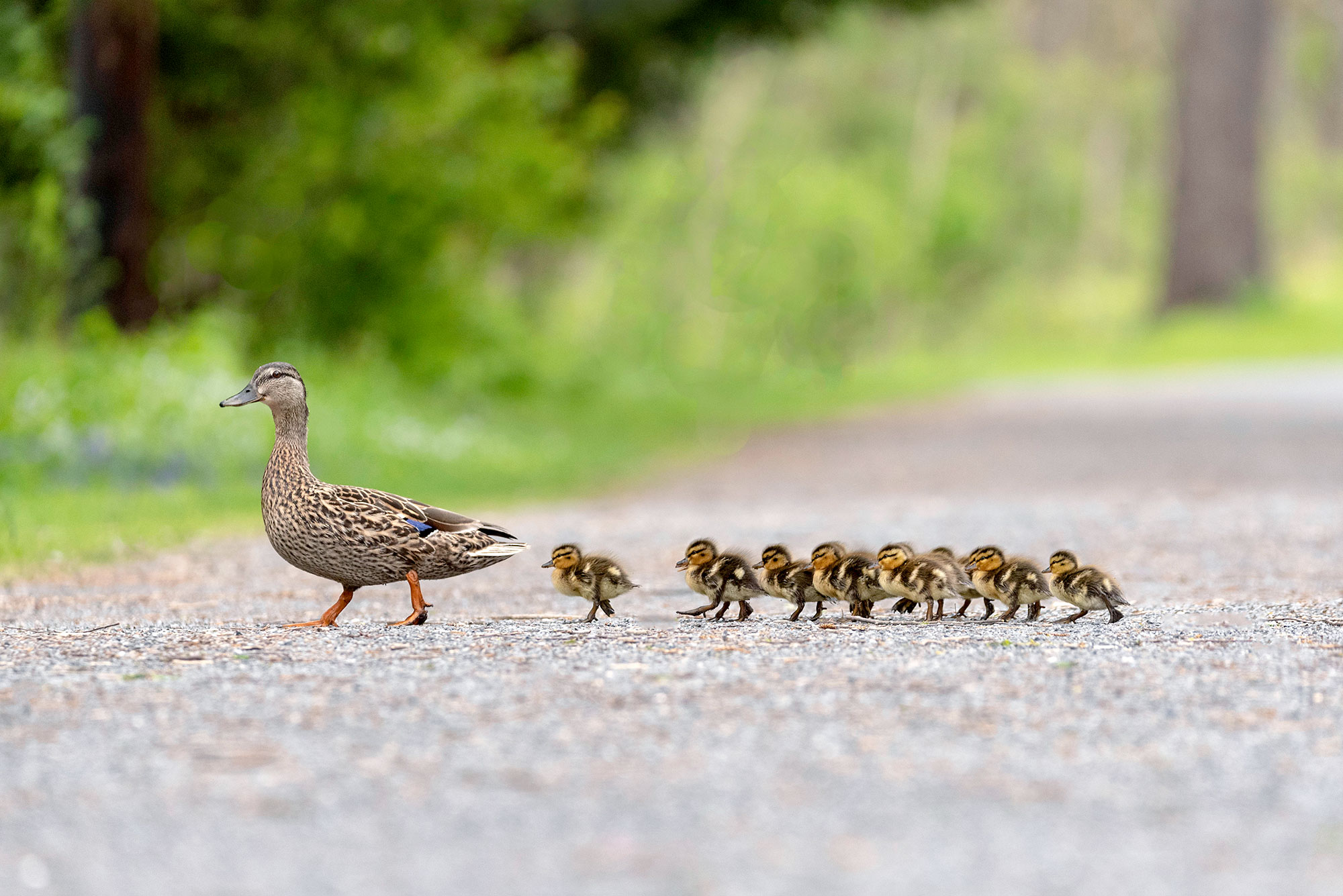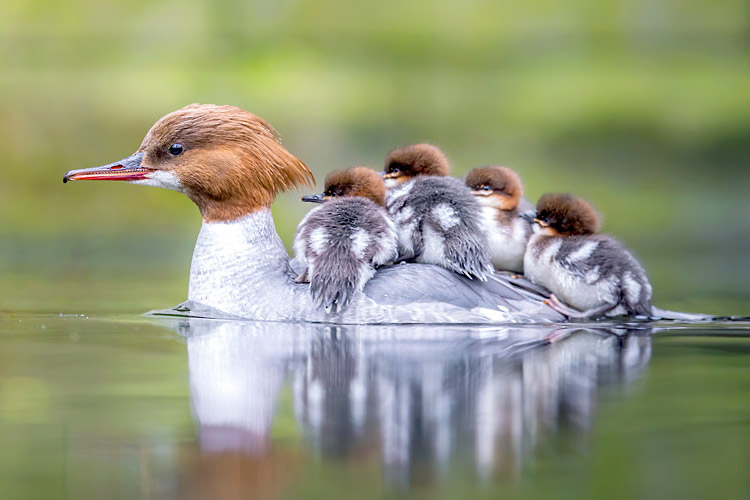Cheep, cheep!
When you were children, you might see yellow chicks chirping at a pet store and end up buying one of those cute and lovely creatures after staring at them for a while. Excited, you would do your best to take good care of it, but unfortunately it would get ill and die a few days later. Why did they die despite your efforts?
Chicks hatch at around 37–38℃ [98.6–100.4℉], the incubation temperature of the hen, and the body temperature of the hatchlings is more than 40℃ [104℉]. After hatching, the hen continues to brood its chicks, because they cannot control their body temperature by themselves. That’s why a chick without its mom would die easily. It isn’t too much to say the role of the mother is related to the life of the young.
Imprinting: recognizing the same species through the mother bird
Chicks and ducks follow their mothers right after hatching. This is called imprinting, one of birds’ distinctive characteristics. The babies of nidifugous birds1 bond instinctively with the first moving object they see within the first hours of hatching and follow it. As nidifugous birds make their nests on the ground, they can be attacked by their natural enemies. As a result, they have this instinct to flee to a safe place, following their mothers. Through imprinting, the mother bird and its babies build a strong relationship, and the baby birds come to have the ability to discern their own species subconsciously.

Konrad Lorenz, an Austrian zoologist who was known as the Father of Greylag Geese, investigated the principle of imprinting. With an intention to give some wild greylag geese babies to a mother goose after hatching, Lorenz studied the new born baby geese for hours and entrusted them to a mother goose. But one of the babies looked very uneasy and fumbled to follow Lorenz. Staying with him for a few hours after hatching, the baby greylag goose imprinted Lorenz as its mom. In the end, he named the baby goose Martina and took care of it. Martina always followed Lorenz and it failed to recognize other greylag geese. Martina liked Lorenz and people more than its own species.
A newly born bird has no instinctive sense to recognize its own race. It just accepts the first object it sees as its mom. That was why Martina acknowledged Lorenz as its mom and did not know about itself, whether it was a goose or not, just like the swan in the fairy tale The Ugly Duckling. Birds that hatch under the wings of their mom, in a natural setting, recognize its real mom and learn their species’ way of life. However, artificially hatched birds don’t. This means that babies can realize what they are through their mother.
Leaving the nest: moving to a new nest, following the mother bird
Nidifugous birds have feathers when they hatch. They can walk and eat. So, as soon as they are born, they leave their nest right away and move to a prolific habitat. In this process, however, baby birds go through countless difficulties.
A mandarin duck, a Korean national monument, once laid eggs at a boiler room on the ninth floor of an apartment building and succeeded in leaving its nest with its young. A mother mandarin duck plucked its feathers to make a nest and spend a full month brooding. Normally, mandarin ducks build their nests on tall trees, and baby mandarin ducks that do not fly yet do a free-fall from their nest built in high places to leave it. So the above mentioned baby mandarin ducks had to jump down to an asphalt street from the ninth floor. People covered the pavement with blankets to help the mandarin ducks, and the babies jumped without fear, following their mother.
Meanwhile, one duck fell to a sewer grate and disappeared. A duck that hatched the last couldn’t follow its mother. Two out of nine eggs failed to hatch, and five out of the seven hatched birds succeeded in leaving their nest with their mother. The baby birds that are born and leave the nest are exposed to constant dangers of natural enemies and environment. If they lose their mother even for a moment, they fall behind forever.

To us, birds look similar and their voices are undistinguishable. How do the mandarin ducklings recognize their mothers just by hearing their voices? There’s an interesting experiment about the mutual cognition between the mother bird and its young. The parent Adelie penguins that share their duties of childrearing are known for recognizing each other through their different voices. Two to three weeks after hatching, when the adult penguins leave for hunting and only baby penguins remain in their habitat, the babies stand shoulder to shoulder to form a group. At that time, scientists played pre-recorded sounds of adult penguins to them, and 90% of the babies recognized their parents’ voices and came out from the group. Those sounds are impossible for human ears to distinguish, but they were different enough to be discerned by the voice analyzer. The parents and their young can recognize each other with imprinted voices that are slightly different.
Raising: the parent birds’ extreme care
The parent birds take care of their young and raise them after their hatching. Some birds even carry their young on their backs just as a human mother would do. Water birds like grebes and ducks carry their young on their backs while swimming. African jacanas and lotus birds carry the young under their wings. When the mother bird crouches and shows a danger signal, the babies hide under the wing of their mother. At that time, the mother bird tightens its wings so that the babies can hang on.
Hens behave in a similar way. When exposed to unfamiliar places or natural enemies, the hen raises a warning signal to call its young and lifts its wings to make its body big enough to embrace the chicks. It is an instinctive behavior to protect its young.
Unlike nidifugous birds, nidicolous birds2 are naked and blind when they hatch. The parents stay longer in the nest and raise their young. While staying, the parents have busy days to feed the young. Long-tailed tits carry food every three to five minutes and take away the young’s excretion with their beaks. Both the male and the female bring food around 250 times a day in total, and every time they catch a couple of caterpillars. That means the parent long-tailed tits catch more than 500 caterpillars every day to raise their young.


Usually, a bird’s nest has no roof, and so when it rains, the parent birds cover the young with their whole bodies. Moreover, they protect their young from the natural enemy like birds of prey or snakes, risking their life, and are always alert to watch over their young so that they will not fall from the high nest. While taking care of the young, they have no strength to trim their feathers and no time to find their own food. As a result, the parent birds grow thin and ugly.
When the time comes for their precious young to be mature and leave the nest, the parent birds show the flap of wings and teach them how to fly, or attract them with food to come out of the nest and fly. It is a necessary process for the young to fly in the blue sky. After the young left, the parent birds circle around the empty nest for a long time, as if they know something.
From hatching to flying, baby birds are able to survive in all sorts of dangers thanks to their parent birds’ utmost care. It is just like chicks that can survive only when they are under the warm wings of the hen. The parent birds protect their young even though they get wet in the rain, and they encourage their young’s first flutter of wings. The parent birds’ chirping that encourages their young is ringing in our ears.
“[H]ow often I have longed to gather your children together, as a hen gathers her chicks under her wings . . .” Mt 23:37
- Reference
- Olin Sewall Pettingill Jr., Ornithology in Laboratory and Field, Academic Press, 1985
- Vitus B. Dröscher, Tierisch erfolgreich: Überlebensstrategien im Tierreich (in German), Goldmann, 1996